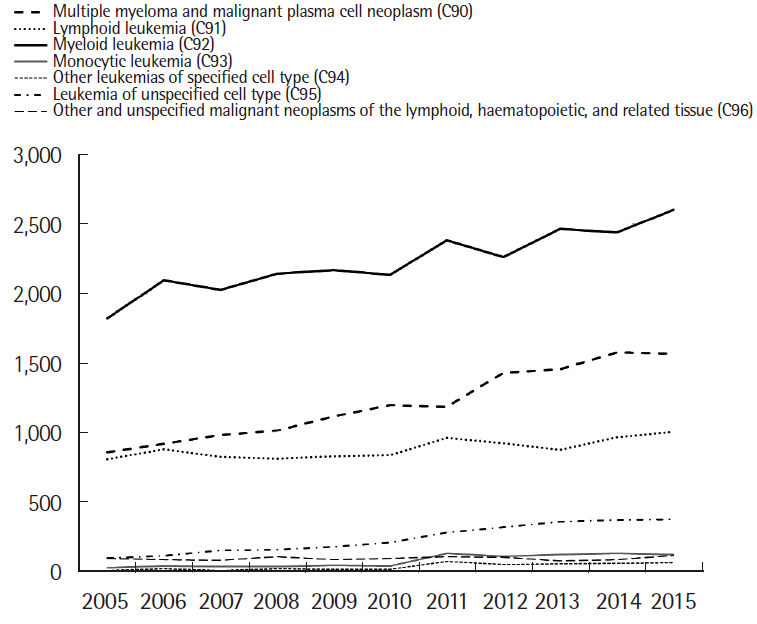Lab Med Online.
2020 Apr;10(2):144-151. 10.3343/lmo.2020.10.2.144.
Gradual Increase in Hematologic Malignancy in Korea from 2005 to 2015 Based on the National Health Insurance Service Data
- Affiliations
-
- 1Department of Laboratory Medicine, Kyung Hee University School of Medicine, Seoul, Korea
- 2Seegene Medical Foundation, Seoul, Korea
- 3Department of Internal Medicine, Seoul National University College of Medicine, Seoul National University Hospital, Seoul, Korea
- 4Research Institute, National Health Insurance Service Ilsan Hospital, Seoul, Korea
- 5Department of Pediatrics, Kyung Hee University School of Medicine, Seoul, Korea
- 6Department of Pediatrics, Chosun University Hospital, Gwangju, Korea
- 7Department of Laboratory Medicine, Kyung Hee University Hospital at Gangdong, Seoul, Korea
- 8Department of Laboratory Medicine, National Health Insurance Service Ilsan Hospital, Goyang, Korea
- KMID: 2512245
- DOI: http://doi.org/10.3343/lmo.2020.10.2.144
Abstract
- Background
Hematologic malignancies have a relatively lower prevalence than major solid cancers, although the incidence of hematologic malignancies has significantly increased in recent years. However, understanding the current status of hematologic malignancy is significantly challenging because basic data regarding this malignancy are insufficient in the Korean population.
Methods
From 2005 to 2015, the status of seven codes of hematologic malignancy, containing 24 subcodes defined using a classification defined by the Korean Classification of Disease-6, was analyzed. The number of new patients, crude incidence rate, prevalence rate, and age-standardized incidence rate were also investigated. Results were analyzed based on National Health Insurance Service (NHIS) data.
Results
The number of new patients showed an overall increase over time and a rate of increase up to 56.7% for 10 years. The number of male patients was higher than that of female patients, with the majority of patients aged greater than 60 years. The incidence and prevalence rates have increased steadily.
Conclusions
Consistent with the previous studies, this study might be useful to understand the current status of hematologic malignancy and might contribute to the improvement of national public healthcare.
Figure
Cited by 1 articles
-
Twenty-year incidence trend of hematologic malignancies in the Republic of Korea: 1999‒2018
Won-Ju Park, Joo-Heon Park, Seunghyeon Cho, Myung Geun Shin
Blood Res. 2021;56(4):301-314. doi: 10.5045/br.2021.2021187.
Reference
-
1. Li J, Smith A, Crouch S, Oliver S, Roman E. 2016; Estimating the prevalence of hematological malignancies and precursor conditions using data from Haematological Malignancy Research Network (HMRN). Cancer Causes Control. 27:1019–26. DOI: 10.1007/s10552-016-0780-z. PMID: 27351920. PMCID: PMC4958130.
Article2. Park HJ, Park EH, Jung KW, Kong HJ, Won YJ, Lee JY, et al. 2012; Statistics of hematologic malignancies in Korea: incidence, prevalence and survival rates from 1999 to 2008. Korean J Hematol. 47:28–38. DOI: 10.5045/kjh.2012.47.1.28. PMID: 22479275. PMCID: PMC3317467.
Article3. Park EH, Lee H, Won YJ, Ju HY, Oh CM, Ingabire C, et al. 2015; Nationwide statistical analysis of myeloid malignancies in Korea: incidence and survival rate from 1999 to 2012. Blood Res. 50:204–17. DOI: 10.5045/br.2015.50.4.204. PMID: 26770948. PMCID: PMC4705046.
Article4. Lee H, Park HJ, Park EH, Ju HY, Oh CM, Kong HJ, et al. 2018; Nationwide statistical analysis of lymphoid malignancies in Korea. Cancer Res Treat. 50:222–38. DOI: 10.4143/crt.2017.093. PMID: 28361523. PMCID: PMC5784621.
Article5. Korea Central Cancer Registry and National Cancer Center. 2017. Annual report of cancer statistics in Korea in 2015. Ministry of Health and Welfare.6. Statistics Korea. 2011. Korean Standard Classification of Diseases and Causes of Death (KCD-6). Statistics Korea;Daejeon:7. Noone AM, Howlader N, Krapcho M, Miller D, Brest A, Yu M, et al. 2018. SEER Cancer Statistics Review, 1975-2015. https://seer.cancer.gov/csr/1975_2015/. Update on Sep. 2018.8. Sant M, Allemani C, Tereanu C, De Angelis R, Capocaccia R, Visser O, et al. 2010; Incidence of hematologic malignancies in Europe by morphologic subtype: results of the HAEMACARE project. Blood. 116:3724–34. DOI: 10.1182/blood-2010-05-282632. PMID: 20664057.
Article9. Terwilliger T and Abdul-Hay M. 2017; Acute lymphoblastic leukemia: a comprehensive review and 2017 update. Blood Cancer J. 7:e577. DOI: 10.1038/bcj.2017.53. PMID: 28665419. PMCID: PMC5520400.10. Song TY, Lee SH, Kim G, Baek HJ, Hwang TJ, Kook H. 2018; Improvement of treatment outcome over 2 decades in children with acute myeloid leukemia. Blood Res. 53:25–34. DOI: 10.5045/br.2018.53.1.25. PMID: 29662859. PMCID: PMC5898990.
Article11. Chihara D, Ito H, Katanoda K, Shibata A, Matsuda T, Sobue T, et al. 2014; Incidence of myelodysplastic syndrome in Japan. J Epidemiol. 24:469–73. DOI: 10.2188/jea.JE20140042. PMID: 25088696. PMCID: PMC4213221.
Article12. Montalban-Bravo G, Garcia-Manero G. 2018; Myelodysplastic syndromes: 2018 update on diagnosis, risk-stratification and management. Am J Hematol. 93:129–47. DOI: 10.1002/ajh.24930. PMID: 29214694.
Article13. Hasserjian RP, Orazi A, et al. Swerdlow SH, Campo E, editors. 2017. Myelodysplastic syndromes: Overview. WHO classi cation of tumours of haematopoietic and lymphoid tissues. Revised 4th ed. International Agency for Research on Cancer;Lyon: p. 98–120.
- Full Text Links
- Actions
-
Cited
- CITED
-
- Close
- Share
- Similar articles
-
- Distribution of Medical Service Use for Facial Palsy Between Medicine and Traditional Korean Medicine Based on Population-Based Data of Korea
- Trends of Gout Prevalence in South Korea Based on Medical Utilization: A National Health Insurance Service Database (2002∼2015)
- Estimated Incidence and Cost Projections of Cataract Surgery in the Republic of Korea
- Community-Based Home Healthcare Project for Korean Older Adults
- A guide for the utilization of Health Insurance Review and Assessment Service National Patient Samples


